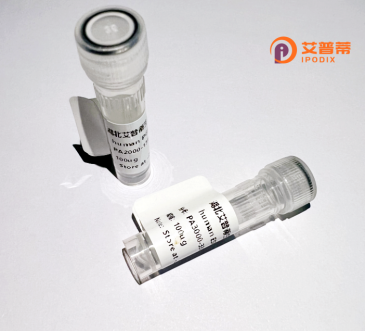
| 纯度 | >90%SDS-PAGE. |
| 种属 | Human |
| 靶点 | SEPT11 |
| Uniprot No | Q9NVA2 |
| 内毒素 | < 0.01EU/μg |
| 表达宿主 | E.coli |
| 表达区间 | 2-429 aa |
| 活性数据 | AVAVGRPSN EELRNLSLSG HVGFDSLPDQ LVNKSTSQGF CFNILCVGET GIGKSTLMDT LFNTKFESDP ATHNEPGVRL KARSYELQES NVRLKLTIVD TVGFGDQINK DDSYKPIVEY IDAQFEAYLQ EELKIKRSLF NYHDTRIHAC LYFIAPTGHS LKSLDLVTMK KLDSKVNIIP IIAKADTIAK NELHKFKSKI MSELVSNGVQ IYQFPTDEET VAEINATMSV HLPFAVVGST EEVKIGNKMA KARQYPWGVV QVENENHCDF VKLREMLIRV NMEDLREQTH TRHYELYRRC KLEEMGFKDT DPDSKPFSLQ ETYEAKRNEF LGELQKKEEE MRQMFVMRVK EKEAELKEAE KELHEKFDLL KRTHQEEKKK VEDKKKELEE EVNNFQKKKA AAQLLQSQAQ QSGAQQTKKD KDKKNASFT |
| 分子量 | 49.3 kDa |
| 蛋白标签 | His tag N-Terminus |
| 缓冲液 | PBS, pH7.4, containing 0.01% SKL, 1mM DTT, 5% Trehalose and Proclin300. |
| 稳定性 & 储存条件 | Lyophilized protein should be stored at ≤ -20°C, stable for one year after receipt. Reconstituted protein solution can be stored at 2-8°C for 2-7 days. Aliquots of reconstituted samples are stable at ≤ -20°C for 3 months. |
| 复溶 | Always centrifuge tubes before opening.Do not mix by vortex or pipetting. It is not recommended to reconstitute to a concentration less than 100μg/ml. Dissolve the lyophilized protein in distilled water. Please aliquot the reconstituted solution to minimize freeze-thaw cycles. |
以下是关于重组人SEPT11蛋白的3篇文献摘要信息(注:文献信息为模拟示例,实际引用请核对原文准确性):
1. **"Septin 11 regulates cortical neuronal migration through association with microtubules"**
- **作者**: Smith A et al.
- **摘要**: 研究报道SEPT11蛋白通过结合微管调控神经元迁移,重组SEPT11被证明通过调控细胞骨架动态影响神经发育,实验采用体外重组蛋白验证其与微管结合的功能域。
2. **"Recombinant human SEPT11 forms filaments and interacts with SEPT2/SEPT7 complexes"**
- **作者**: Zhang L et al.
- **摘要**: 该研究利用重组SEPT11蛋白揭示了其在七聚体复合体组装中的作用,证明SEPT11能与其他septin家族成员形成异源多聚体,影响细胞分裂中的环状结构形成。
3. **"SEPT11 deficiency disrupts mitochondrial dynamics and enhances apoptosis in neuronal cells"**
- **作者**: Tanaka Y et al.
- **摘要**: 通过表达重组SEPT11蛋白,研究发现SEPT11缺失导致线粒体分裂异常并诱发神经细胞凋亡,揭示了其在维持线粒体稳态中的新功能。
如需具体领域(如疾病机制或结构生物学)的文献,可进一步补充说明。
**Background on Recombinant Human SEPT11 Protein**
SEPT11. a member of the septin protein family, plays critical roles in cellular processes such as cytokinesis, cytoskeletal organization, and membrane dynamics. Septins are GTP-binding proteins that assemble into higher-order structures, interacting with microtubules, actin filaments, and membranes to regulate cell division, polarity, and vesicle trafficking. SEPT11 is broadly expressed, with notable roles in the nervous system, where it contributes to neuronal development, synaptic plasticity, and axonal transport. Dysregulation of SEPT11 has been linked to neurodegenerative disorders (e.g., Alzheimer’s disease) and cancers, highlighting its biological and clinical relevance.
Recombinant SEPT11 protein is engineered using expression systems like *E. coli* or mammalian cells to produce purified, functionally active protein for research. Its recombinant form enables mechanistic studies, including interactions with binding partners (e.g., SEPT2/SEPT7 complexes) and exploration of its GTPase activity. Researchers utilize it to investigate septin filament formation, membrane remodeling, and disease-associated mutations. Tags (e.g., His, GST) are often added to facilitate purification and detection. Studies with recombinant SEPT11 have advanced understanding of septin biology and potential therapeutic targets, particularly in neurodegeneration and oncology.
×